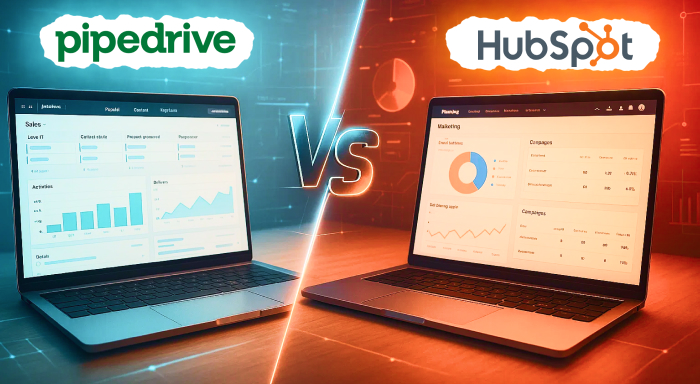n today’s data-driven digital world, businesses need advanced tools to help them track and manage customer data across multiple touch points. CRM platforms offer the most efficient solution for the evolving business needs. Two such platforms are Pipedrive and HubSpot. But which CRM is the best for the sales and growth of your business? This guide on Pipedrive vs HubSpot provides a comprehensive comparison between the two, including their features, pricing, and performance. It also provides a framework to assist you in your decision-making process.
Pipedrive vs HubSpot: An Overview
Tracking customer interactions, managing data, and streamlining operations can be tedious without assistance. Traditional methods included numerous files and spreadsheets with manual inputs. These methods are no longer relevant in the digital world. A Customer Relationship Management (CRM) system provides a centralised solution for your customer data needs with advanced analytics, enhancing productivity, customer experience, and performance monitoring.
Pipedrive:
Pipedrive is an Estonian company, founded in 2010. This CRM platform was designed with a sales-focused approach to offer simplicity and efficiency. Pipedrive provides an intuitive pipeline management system that enables the sales teams to monitor deals across dynamic stages.
Key Characteristics:
- Pipeline-centric
- Sales automation tools
- Contact management
- Sales forecasting
HubSpot:
HubSpot was established in 2006 in Massachusetts, USA, and offers a comprehensive CRM platform that includes tools for marketing, sales, customer service, and other business operations.
Key Characteristics:
- All-in-one platform
- Marketing automation
- Content management
- Analytics dashboard
Pipedrive vs HubSpot: Comprehensive Feature Comparison
A CRM platform is a strategic decision that can impact your business’s operations, sales, and growth. Such a decision cannot be made without understanding the features that each platform offers and how it aligns with the objectives of your company.
| Category | Pipedrive | HubSpot |
| User Interface | Clean and intuitive; easy to navigate. | Feature-rich interface; requires a learning curve. |
| Marketing Capabilities | Basic lead capture and email marketing; limited automation. | Advanced marketing functionalities and content management. |
| Sales Management | Visual pipeline with streamlined sales process. | Broader data visibility across marketing, sales, and service. |
| Customisation Potential | Sales-focused operational customisation. | Extensive customisation for different departments. |
| Automation | Basic workflow automations with a focus on sales. | Complex multi-purpose workflow automations. |
| AI-driven tools | Sales assistant and email writer. | SEO tools, content generator, and analytics. |
| Third-Party Integrations | 400+ integrations for sales tools. | 1000+ integrations for diverse services. |
| Reporting and Analytics | Sales performance and pipeline analytics. | Comprehensive reporting with advanced dashboards. |
| Mobile functionality | Superior app for field sales team. | Multi-departmental mobile access with some limitations. |
| Scalability Support | Supports scaling for the sales team. | Supports scaling for multiple departments. |
| Customer Support | 24/7 chat and email support; dedicated support for higher tiers. | Email and chat support for paid tiers. HubSpot Academy for self-learning. |
Pipedrive vs HubSpot: Pricing Comparison
It is important to choose a CRM service that is compatible with your budget. There is a significant difference in the offered pricing plans between Pipedrive and HubSpot, along with the included features.
Pipedrive:
- Offers a 14-day trial without credit card information.
- Cost-effectiveness at higher tiers.
- Scalable plans with add-ons.
HubSpot:
- Offers permanent free access at entry level.
- Prices increase significantly at higher tiers.
- Two types of billing plans – monthly and annually – except for the Enterprise plan.
| Plan Tier | Pipedrive (billed annually) | HubSpot (billed annually) |
| Entry-level | Lite: $14 per user | Free |
| Mid-tier | Growth: $24 per user | Starter: $9 per user |
| Intermediary-tier | Premium: $49 per user | Professional: $800 for 3 users |
| Top-tier | Ultimate: $69 per user | Enterprise: $3600 for 5 users |
Pipedrive vs HubSpot: Detailed Performance Comparison
Along with features, performance varies across different platforms. Pipedrive and HubSpot excel at different aspects, while there might be some limitations with each. Below is a detailed walk-through of their performance metrics:
| Metrics | Pipedrive | HubSpot |
| Set up and Implementation | Quick implementation within days. | Comprehensive setup might take weeks. |
| Speed and Responsiveness | Speed and performance optimisation using API v2 touchpoints. | Advanced features and extensive customisation might affect the loading time. |
| Data Processing | Efficient handling of large data; minimum performance degradation. | Complex data relationships with multiple integrations may reduce processing speed. |
| Scalability | Consistent performance | Heavy use may reduce response time. |
| Search and Filtering | Fast response to database queries; optimised search algorithms. | Advanced filtering; takes longer to respond to queries. |
| Reporting and Analytics | Instant analysis of sales metrics. | Cross-departmental analysis needs more time. |
| Mobile App | Lightweight, better offline functionalities, and faster sync. | More features, limited offline functionalities, and real-time sync. |
Security Performance
- Pipedrive:
Security protocols are lightweight and cause minimum performance overhead.
- HubSpot:
Full-scale security features that may cause slight delays in processing.
Backup and Recovery Speed
- Pipedrive:
The impact of downtime on the data is minimum with fast recovery.
- HubSpot:
The backup systems are well-developed with a longer recovery process.
Pipedrive vs HubSpot: Factors that Support Decision-making
When choosing between Pipedrive vs HubSpot, there are many factors that can assist you in the decision-making process. Below is a decision framework to guide you:
Business Size and Complexity
Depending on the size and complexity of your operations, you select the platform most suitable for you.
Pipedrive (ideal for):
- Startups and small enterprises
- Sales-focused operations (with minimal marketing requirements)
- Simple sales cycle
- Limited budget
- Quick implementation
HubSpot (ideal for):
- Medium and large enterprises
- Integrated operations with dedicated marketing and sales departments
- Complex customer journeys
- Comprehensive business growth with resource availability
- Sustainable scalability
Small businesses with budget restrictions and limited marketing needs can use HubSpot’s free tools to begin their lead generation and email marketing journey.
Industry-specific Considerations
- Tech Industry
- Pipedrive: Ideal for B2B SaaS with simple sales cycles.
- HubSpot: Businesses that require extensive content marketing can opt HubSpot.
- Professional Services
- Pipedrive: Best suited for consulting firms and agencies with straightforward and relationship-based sales operations.
- HubSpot: Better for firms that require lead generation campaigns.
- E-commerce
- Pipedrive: Limited features for the needs of the e-commerce industry.
- HubSpot: Enables strong integration with e-commerce platforms.
- Manufacturing
- Pipedrive: Suitable for B2B manufacturing that has long sales cycles.
- HubSpot: Manufacturers with extensive distribution, overseas operations, and complex sales journeys will find it ideal.
If you believe the above recommendations are not the perfect fit for your businesses and want to explore more options, you can consider other CRM platforms like Zoho or Salesforce.
Best Practices for CRM Implementation
Irrespective of the CRM platform that you choose, these implementation practices ensure successful adoption for desirable results:
- Define objectives that align with your company’s vision.
- Ensure clean and accurate data migration.
- Establish user access protocols.
- Integrate essential tools first.
- Provide adequate training for your teams.
- Regularly monitor performance metrics.
For effective implementation, you can outsource the services to business like OutRightCRM. Such companies offer CRM customisations tailored to your business needs.
Conclusion
CRM platforms are the need of the hour for businesses to grow and scale efficiently. Startups, SMEs, and large organisations can all benefit from effective CRM adoption. While Pipedrive and HubSpot are both excellent platforms, they offer different features, pricing, and performance metrics. This comparative guide on Pipedrive vs HubSpot highlights the two distinct approaches that businesses can adopt for their requirements. Utilise the decision-making layout to align your choice with the size, operational framework, budget constraints, and goals of your business. Achieve success with the right CRM platform perfect for your business.



